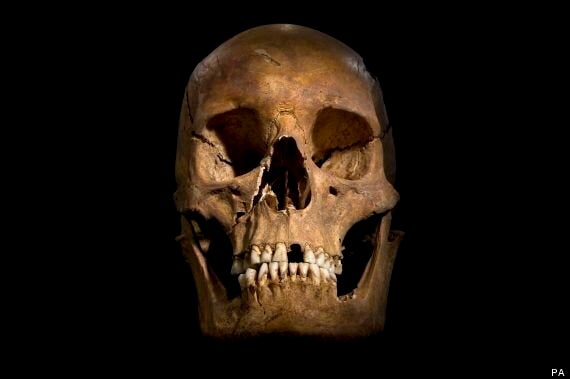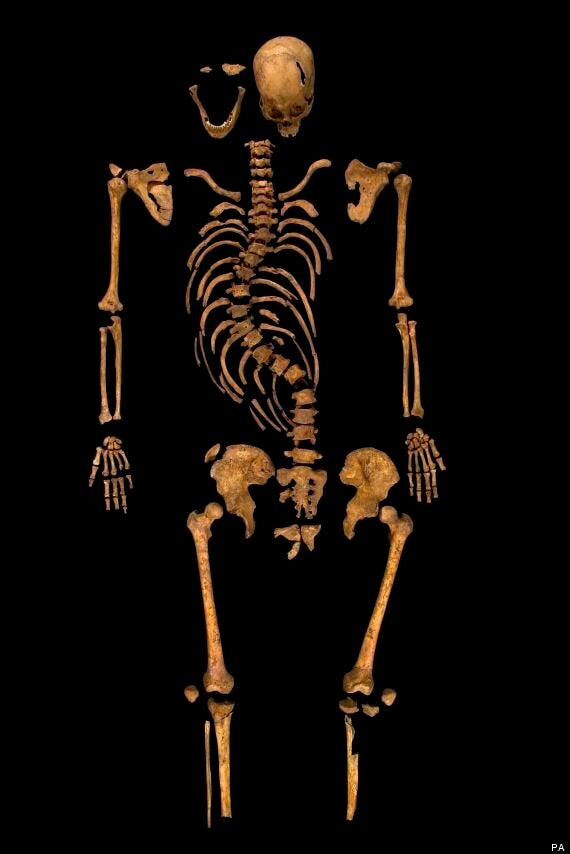Scientists have announced plans to sequence King Richard III's genomes in an attempt to discover more about the 15th century monarch, including what he really looked like.
Richard's remains were discovered in 2012 amid the buried ruins of an old friary beneath a Leicester car park.
Although portraits of the king exist, they were painted around 50 years after his death, in 1485 during the final battle of the bloody Wars of the Roses.

The Skull of Richard III
Scientists hope to find out the king's hair and eye colour and even the shade of his skin from mapping "all three billion letters of his genome".
Their work could also shed light on the health of Richard, who suffered from the spine-curving condition scoliosis, revealing what diseases he may have been predisposed to later in life had he not become the last king of England to die in battle.
They could examine whether Richard was predisposed to obesity or would have been likely to suffer from Alzheimer's disease and even assess one element of his diet, whether or not he was lactose intolerant.
Richard will be the world's first known figure from ancient history to have his genomes sequenced.
In the past, only a small number of ancient anonymous individuals - Neanderthal specimens, a Greenlandic Inuit, a hunter gatherer from Spain and a 5,300-year-old frozen body found in the Alps - have had their genomes sequenced.
Scientists must carry out their work before Richard is re-interred, a process which has become the subject of a legal battle.
His relatives are fighting for the remains to be buried at York Minster, claiming it was the king's wish, instead of the cathedral in Leicester, the city where he was found.
The team say that by mapping out his genome they will ensure that researchers can continue to learn about Richard's past even once his remains have been interred. As the genetic basis of new diseases becomes known, these can be tested for.

Richard III's complete skeleton
Dr Turi King at the University of Leicester - where scientists revealed the remains to be those of Richard III last year - is the geneticist carrying out the research.
She said sequencing Richard's genomes "will allow insight into his genetic makeup and predisposition towards disease", adding "one of the things I'm particularly interested in looking at is, can we look to see whether or not Richard III was predisposed towards scoliosis?"
Unveiling the plans at a press conference in London, she said: "You can start to sequence bacteria and viruses...it will be interesting to see whether or not we see any evidence of infection in Richard."
She added: "There are no contemporary portraits of Richard. All the portraits that exist post-date his death by about 40 to 50 years onwards. So it's going to be interesting to see what the genetic information provides in relation to what we know from the portraits."
Richard left no descendants but scientists will sequence the remains of his 17th generation nephew Michael Ibsen. It will be the first time any ancient figure has been DNA tested against a living relative.
Asked how she would respond if relatives complained that extracting Richard's DNA by grinding a bone sample was undignified, she said: "It's been 500 years. There are no close relatives alive today....He left no descendants himself but there are descendants of his family.
"But they're not close family members. We will be able to learn more about Richard and add another layer of information. It will tell us more about him as an individual. He's going to become a resource for people.
"People are really interested in Richard III and if this provides a way of informing people about genetics and identity, I like the fact that he's becoming a resource for us."
Dr Dan O'Connor, head of medical humanities at the Wellcome Trust, which is helping to fund the work, said if research revealed that Richard had a different eye or hair colour to that of his paintings, in which he has dark hair and dark eyes, it would be of huge interest to historians.
"If it turned out that the genomes suggest he had green eyes and blond hair... why did the artists at the time choose to present him in a certain way? Why was a very controversial king, at a time of great upheaval in England, drawn in such a way?," he said.
Dr King added: "We know that the paintings were altered later...so it will be interesting to see how he looked."
Dr O'Connor said that the work raised "ethical questions" such as "when is it acceptable for a historical figure to become public property"?
"Obviously Richard died 500 years ago, so enough time has passed so that particular ethical issue no longer pertains, but it's something that researchers are increasingly going to have to think about as historical figures' remains are able to have their whole genomes sequenced."
He added: "This is not to set a precedent to suggest that every 500 years, after the death of a monarch, we automatically sequence their genomes."
They hope to publish their work, which is costing £100,000, in a year's time and information will be placed on an online database for the public, historians, geneticists, archaeologists, teachers and scientists to use.
Scientists also hope to find funding to look at the DNA of the calculus on Richard's teeth to discover what he was eating.
The king, who reigned from 1483, was only found following a lengthy campaign by members of the Richard III Society.
The legal battle over where his remains should be buried was adjourned at the High Court last year.